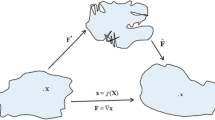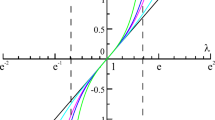Abstract
The nonlinear elastic response of a class of materials for which the deformation is subject to an internal material constraint described in experiments by James F. Bell on the finite deformation of a variety of metals is investigated. The purely kinematical consequences of the Bell constraint are discussed, and restrictions on the full range of compatible deformations are presented in geometrical terms. Then various forms of the constitutive equation relating the stress and stretch tensors for an isotropic elastic Bell material are presented. Inequalities on the mechanical response functions are introduced. The importance of these in applications is demonstrated in several examples throughout the paper.
This paper focuses on homogeneous deformations. In a simple illustration of the theory, a generalized form of Bell's empirical rule for uniaxial loading is derived, and some peculiarities in the response under all-around compressive loading are discussed. General formulae for universal relations possible in an isotropic elastic, Bell constrained material are presented. A simple method for the determination of the left stretch tensor for essentially plane problems is illustrated in the solution of the problem of pure shear of a materially uniform rectangular block. A general formula which includes the empirical rule found in pure shear experiments by Bell is derived as a special case. The whole apparatus is then applied in the solution of the general problem of a homogeneous simple shear superimposed on a uniform triaxial stretch; and the great variety of results possible in an isotropic, elastic Bell material is illustrated. The problem of the finite torsion and extension of a thin-walled cylindrical tube is investigated. The results are shown to be consistent with Bell's data for which the rigid body rotation is found to be quite small compared with the gross deformation of the tube. Several universal formulas relating various kinds of stress components to the deformation independently of the material response functions are derived, including a universal rule relating the axial force to the torque.
Constitutive equations for hyperelastic Bell materials are derived. The empirical work function studied by Bell is introduced; and a new constitutive equation is derived, which we name Bell's law. On the basis of this law, we then derive exactly Bell's parabolic laws for uniaxial loading and for pure shear. Also, form Bell's law, a simple constitutive equation relating Bell's deviatoric stress tensor to his finite deviatoric strain tensor is obtained. We thereby derive Bell's invariant parabolic law relating the deviatoric stress intensity to the corresponding strain intensity; and, finally, Bell's fundamental law for the work function expressed in these terms is recovered. This rule is the foundation for all of Bell's own theoretical study of the isotropic materials cataloged in his finite strain experiments on metals, all consistent with the internal material constraint studied here.
Similar content being viewed by others
References
J.F. Bell, Contemporary perspectives in finite strain plasticity. Int. J. Plasticity 1 (1985) 3–27.
J.F. Bell, Experiments on the kinematics of large plastic strain in ordered solids. Int. J. Solids Struc. 25 (1989) 267–288.
T.C.T. Ting, Determination of C1/2, C-1/2 and more general isotropic tensor functions of C. J. Elasticity 15 (1985) 319–323.
A. Wineman and M. Gandhi, On local and global universal relations in elasticity. J. Elasticity 14 (1984) 97–102.
K.R. Rajagopal and A.S. Wineman, New universal relations for nonlinear isotropic elastic materials. J. Elasticity 17 (1987) 75–83.
C. Truesdell and W. Noll, The Nonlinear Field Theories of Mechanics. Flügge's Handbuch der Physik III/3. New York: Springer-Verlag (1965).
J.F. Bell, Plane stress, plane strain, and pure shear at large finite strain. Int. J. Plasticity 4 (1988) 127–148.
M.F. Beatty and D.O. Stalnaker, The Poisson function of finite elasticity. J. Applied Mech. 53 (1986) 807–813.
J.F. Bell, Continuum plasticity at finite strain for stress paths of arbitrary composition and direction. Arch. Rational Mech. Anal. 84 (1983) 139–170.
R.C. Batra, Deformation produced by a simple tensile load in an isotropic elastic body. J. Elasticity 6 (1976) 109–111.
M.F. Beatty, A class of universal relations in isotropic elasticity theory. J. Elasticity 17 (1987) 113–121.
M.F. Beatty, A class of universal relations for constrained, isotropic elastic materials. Acta Mech. 80 (1989) 299–312.
R.C. Batra, On the coincidence of the principal axes of stress and strain in isotropic elastic bodies. Letters Appl. Engng. Sci. 3 (1975) 435–439.
M.F. Beatty, Topics in finite elasticity: Hyperelasticity of rubber, elastomers, and biological tissues—with examples. Applied Mech. Revs. 40 Part 1 (1987) 1699–1734.
J. Stickforth, The square root of a three-dimensional positive tensor. Acta Mech. 67 (1987) 233–235.
R.S. Rivlin, Some applications of elasticity theory to rubber engineering. Proc. 2nd Tech. Coinf. London, June 23–25, 1948. Cambridge: Heffer (1948), pp. 204–213.
C. Truesdell and R. Toupin, The Classical Field Theories of Mechanics, Flügge's Handbuch der Physik III/1. New York: Sprnger-Verlag (1960).
J.F. Bell, Experiments on the coaxiality and symmetry of strain and stress tensors during rotation at large plastic strain. Private communication, November 1988. This preliminary report was later revised as reference [20].
H.S. Sellers and A.S. Douglas, A physical theory of finite plasticity from a theoretical perspective. To appear in Int. J. Plasticity.
J.F. Bell, Material objectivity in an experimentally based incremental theory of large finite plastic strain. Int. J. Plasticity 6 (1990) 293–314.
Author information
Authors and Affiliations
Rights and permissions
About this article
Cite this article
Beatty, M.F., Hayes, M.A. Deformations of an elastic, internally constrained material. Part 1: Homogeneous deformations. J Elasticity 29, 1–84 (1992). https://doi.org/10.1007/BF00043445
Received:
Issue Date:
DOI: https://doi.org/10.1007/BF00043445




